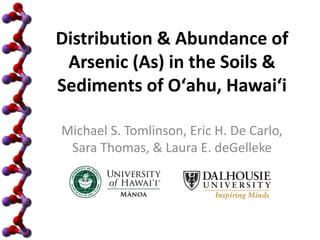Oahu Soil & Sediment As
- 1. Distribution & Abundance of Arsenic (As) in the Soils & Sediments of O ªahu, Hawai ªi Michael S. Tomlinson, Eric H. De Carlo, Sara Thomas, & Laura E. deGelleke
- 2. O ªahu, Hawai ªi O ªahu Hawai ªi Maui Kaua ªi Moloka ªi LƒÅna ªi Kaho ªolawe Ni ªihau Ordnance Reef Remedial Investigation Diamond Head HonoluluBarbers Point Ka ªena Point Kahuku Point Makapu ªu Point Kailua KƒÅne ªohe MƒÅmala Bay Wai ªanae
- 3. Ordnance Reef RI – Where did the As come from? Nonmetric Multidimensional Scaling (NMDS)
- 4. Anomalous [As] were seen in bed sediments during USGS NAWQA Study A = Agriculture F = Forested U = Urban M = Mixed
- 5. Anthropogenic Trace Elements? ??? Arsenical Pesticides (e.g., NaAsO2), Super-phosphate Fertilizers?
- 7. Anomalous [As] were reported in soil data compiled by HIDoH
- 8. Arsenic Sources & Transfer
- 9. O ªahu Relief, Isohyets, & UHM Samples
- 10. As & Former Sugarcane Land
- 11. As & Former/Current Pineapple Land
- 13. As in Waiakeakua Stream
- 14. Why is arsenic in Waiakeakua Stream?
- 15. Where does the arsenic come from? Possibly iron & zinc micronutrient fertilizer from silver mine tailings used by nurseries to green-up plants (Human Health Risk Assessment for Long-term Residential Use of Ironite® Lawn and Garden Nutrient Supplement - ADEQ, 1998)
- 16. Conclusions ‚Ä¢ As occurs in nearshore O ªahu sediments ‚Ä¢ NMDS indicates a loose association with terrestrial elements (probably from runoff) ‚Ä¢ As occurs in some NAWQA stream sediments associated with agriculture ‚Ä¢ PCA of NAWQA sediments indicate a loose association with petrogenic elements but not anthropogenic elements ‚Ä¢ HIDoH data show elevated [As] but the distribution is spotty
- 17. Conclusions (continued) ‚Ä¢ Some As may be associated with past sugarcane and/or pineapple agriculture (arsenical pesticides ‚Äì ceased late 1940s, super-phosphate fertilizers, etc.) ‚Ä¢ The highest [As] on O ªahu, however, are found in mixed land use/forested areas ‚Ä¢ Arsenical pesticides & micronutrient fertilizers (e.g., Ironite¬Æ) used in nurseries may explain some As ‚Ä¢ And, finally ‚Ķ
- 18. Yes, arsenic occurs naturally in Arizona, however, do not totally discount anthropogenic sources Photo taken in Flagstaff Sam’s Club
- 19. Mahalo nui loa! Questions? MƒÅlama i ko mƒÅkou ªƒÅina (Care for our land)



![Anomalous [As] were seen in bed
sediments during USGS NAWQA Study
A = Agriculture
F = Forested
U = Urban
M = Mixed](https://image.slidesharecdn.com/6135159d-c5d2-48dd-b52e-d95bf74f3589-150418162249-conversion-gate02/85/Oahu-Soil-Sediment-As-4-320.jpg)


![Anomalous
[As] were
reported in
soil data
compiled
by HIDoH](https://image.slidesharecdn.com/6135159d-c5d2-48dd-b52e-d95bf74f3589-150418162249-conversion-gate02/85/Oahu-Soil-Sediment-As-7-320.jpg)








![Conclusions
‚Ä¢ As occurs in nearshore O ªahu sediments
• NMDS indicates a loose association with
terrestrial elements (probably from runoff)
• As occurs in some NAWQA stream
sediments associated with agriculture
• PCA of NAWQA sediments indicate a loose
association with petrogenic elements but
not anthropogenic elements
• HIDoH data show elevated [As] but the
distribution is spotty](https://image.slidesharecdn.com/6135159d-c5d2-48dd-b52e-d95bf74f3589-150418162249-conversion-gate02/85/Oahu-Soil-Sediment-As-16-320.jpg)
![Conclusions (continued)
• Some As may be associated with past
sugarcane and/or pineapple agriculture
(arsenical pesticides – ceased late 1940s,
super-phosphate fertilizers, etc.)
‚Ä¢ The highest [As] on O ªahu, however, are
found in mixed land use/forested areas
• Arsenical pesticides & micronutrient
fertilizers (e.g., Ironite®) used in nurseries
may explain some As
• And, finally …](https://image.slidesharecdn.com/6135159d-c5d2-48dd-b52e-d95bf74f3589-150418162249-conversion-gate02/85/Oahu-Soil-Sediment-As-17-320.jpg)

